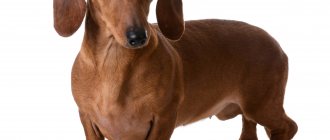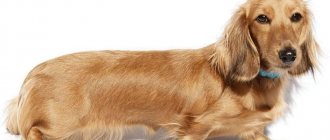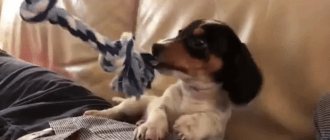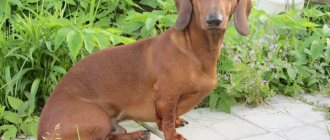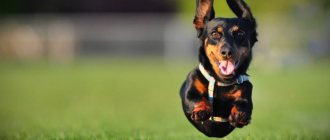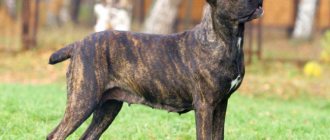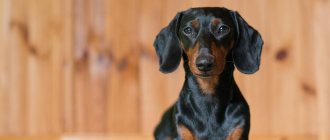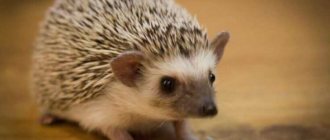The dachshund is both angel eyes and the character of a little devil. Despite its compact size, the dog of this breed is energetic and combative, which in no way prevents it from getting along well in a city apartment.
A dachshund can become a child’s best friend, a hunter, and a companion. The main thing is to take good care of her and welcome her excitement, playfulness and intelligence.
Breed characteristics
| Short description | |
| Origin: | Germany |
| Conditions of detention: | Apartment, house |
| Purpose: | Hunting dog, companion dog |
| Color: | Solid: brown, black, red, sand, two-color: black and tan or brown and tan, merle: black, auburn or gray with spots, brindle |
| Wool length: | Short, long |
| Adult dog size: | Height 30-35 cm, weight – 5-6 kg |
| Average life expectancy: | 10-12 years |
| Walk: | Walking twice a day is required |
| Physical activity needs: | High physical activity needs (1.5-2 hours of active walking or training daily) |
| Fédération Cynologique Internationale (FIC) classification: | Group 4: dachshunds; Section 1: dachshunds |
| Puppy price: | From 5,000 to 20,000 rubles. Without pedigree - up to 10,000 rubles, pet class - 10,000-12,000 rubles, breed class - 15,000 rubles, show class - 20,000 rubles |
Where to buy and price
The dachshund is one of the most popular dogs in Russia, so finding a purebred puppy will not be difficult. Officially registered nurseries exist not only in cities with a population of over a million.
List of nurseries:
- Dax Design (Moscow);
- Ulayter (Moscow);
- Tornado Blaze (Moscow);
- From the Golden Storehouses (Moscow);
- From Rainbow Dreams (Rostov-on-Don);
- Svarta Pim (St. Petersburg);
- Caucasus Lake Baikal (Angarsk);
- From the Omsk Fortress (Omsk);
- Crazy Toy (Ryazan);
- Magic of the Stars (Rybinsk).
Average price for puppies: 15,000-35,000 rubles.
Nicknames
You can name a boy dachshund with either a funny or an aristocratic name: Count, Hamilton, Theodore, Zeus, Tim, Denis, Chuck, Charlie, Cactus, Sprat, Kex, Bumblebee, Shustrik. A name for a girl can be gentle or perky: Chloe, Florence, Pixie, Button, Mimi, Plusha, Toffee, Snezhka, Sophie, Donna.
History of the origin of the species
Some dog handlers are confident that the breed is aboriginal. Images of cute short-legged and long-bodied dogs are found on the tombs of ancient Egyptians. The assumption that the Dachshund was bred there can be scientifically proven.
The breed acquired its modern appearance in Germany (16th century), this country is considered its homeland. The animal is classified as a mutated hound due to the disease chondrodystrophy (a pathology in which the whole body grows, but the legs remain short). One way or another, the ancestors of the breed have not yet been found. It is believed that these are Bracchi hounds.
The name is translated from German as “badger” . In Russia, until the 19th century, dogs were called badgers, and later the German “Dax” into “Dachshund” .
Until 1870, when the standard was recognized, dogs were modified and new subspecies were created. That's when smaller Dachshunds and long-haired ones appeared.
Diseases and life expectancy
Dachshunds are prone to excess weight and spinal diseases. Obesity is very dangerous: it increases the load on the back and leads to irreversible consequences.
The most common diseases include:
- Osteoporosis.
- Discopathy. This disease manifests itself in the displacement of intervertebral discs, which leads to compression of the spinal cord. Discopathy can be genetic or occur in sedentary dogs.
- Acanthosis nigricans. It causes skin damage, excessive pigmentation, baldness, and the formation of severe folds. In addition, the disease is accompanied by a stench. Acanthosis nigricans in a dachshund can be a consequence of a genetic pathology or frequent diathesis. Possible causes include diabetes and hypothyroidism.
- Ear mite.
- Epilepsy.
- Cataract.
- Diabetes.
- Diseases of the heart, urinary tract.
Problems with the spine are often accompanied by impaired motor activity. If your dachshund's paws fail, you should immediately consult a doctor. Treatment can be either medicinal or surgical. During the recovery period, massage, swimming and special exercises are prescribed. On average, dachshunds live 12-15 years.
Distinctive features
Dachshunds are divided into 9 subspecies . There are 3 height varieties: standard (35 cm at the withers), mini (30-35 cm), rabbit (up to 30) .
Each of them can be smooth-haired, wire-haired or long-haired. One way or another, one standard has been written for the breed. All subspecies retain proportions and basic features.
- The head is conical and oblong, tapering towards the nose. The brow ridges are highlighted and the stop is smooth.
- The muzzle is equal to the length of the skull. The jaw is strong with a full set of teeth and bite . The lips are narrow.
- The nose is big. Color varies depending on coat color.
- The eyes are almond-shaped and small in size, set slantingly and widely. A chocolate tint of the iris is possible.
- The ears are set high and hang down, while they are long and narrow, with rounding at the ends.
- The body is oblong, strong and muscular. The back is long and straight, with pronounced withers. The chest is wide and significantly lowered. The neck is elongated, but stands proudly, without dewlap.
- The tail is short and does not touch the ground, located just below the back.
- The limbs are short and widely set. The paws are oval-shaped, strong and large. The movements are jerky, slightly hobbling and smooth.
- smooth-haired coat : lies close to the body, while being thin and smooth; Wire -haired : wiry and thick, also has a dense undercoat; longhaired : has medium length, soft, wavy and has a fluffy undercoat .
- Colors . Solid : black, sand, red, brown, bi-color : brown and tan or black and tan, merle : auburn, black, brindle or gray with spots.
Selection instructions
When choosing, you should pay attention to the appearance of the dachshund. She must have:
- wedge-shaped elongated head;
- pronounced brow ridges;
- White teeth;
- slanted brown eyes;
- thin floppy ears;
- short front legs;
- hind legs spread apart;
- shoulder strength;
- a rather long tail with its tapering towards the tip.
Photo of an adult dog
What color is considered a breed defect?
A dog lover can choose a dachshund with a color according to the breed standard or an unusual color. If you plan to participate in exhibitions, you need the first option. When looking for a dachshund for home and family, it is worth taking a closer look at dogs with rare coat colors, even if they are considered a defect in the breed. The most unusual among them:
- spotted;
- black and brindle;
- isabella;
- double merle;
- cream.
The latter color occurs only in long-haired dachshunds.
Photos of puppies
Separation by color
Dachshunds are divided not only by size and type of coat, but also by color.
The classic color of the dachshund, known throughout the world, is black and red. It comes in solid, marble, tan and brindle. The wire-haired species has a color called “boar” or simply gray. Single-colored red dogs are compared to deer for their nobility of color. In species with a solid color, black tips on the coat are allowed.
Marble color is distinguished by a blurring of spots on the main color, beige and gray. This color is characterized by black or brown claws and nose.
The brindle color is considered very rare. The peculiarity is the striped color, usually on a red or yellow background.
The isabella color is considered prohibited. Described as a bleached brown color. Dogs of this color suffer from skin diseases, and their immunity is greatly reduced.
Features of character and behavior
The breed is a hunting breed, so the dogs are temperamental, wayward, but very smart and active . They learn quickly, remember commands and become good helpers.
Dachshunds are often included in the list of the most aggressive animals. They cannot boast of a balanced nervous system, so they can really react angrily to any irritant. With proper upbringing, this rarely happens.
Advantages
The advantages of the breed include:
- Goodwill, friendliness, lack of innate aggression, devotion to family;
- Positive thinking, activity until old age;
- Good relationship with children while maintaining distance;
- Good intellectual abilities, quick learner;
- Hunting instincts and developed qualities: sense of smell, vision, speed, endurance, agility;
- Security qualities;
- Variability (you can choose your pet by size, color and coat length).
Flaws
Main breed disadvantages:
- An unbalanced nervous system (which can lead to attacks of aggressiveness);
- Stubbornness, willfulness, tendency to dominate;
- Selfishness, jealous attitude towards the owner and personal belongings;
- Intolerance towards small children and their antics, towards small animals;
- Destructiveness (gnaw, tear, spoil things);
- Tendency to run away due to strong instinct.
Mobility
Walking is very important for the health of the animal. They help prevent excess weight gain.
In addition, this is an opportunity to communicate with the outside world and with the owner. Dachshunds love to run fast, but they should not be allowed to jump from different heights or objects of any height.
In this case, there is a danger of displacement of the vertebrae and injury, which will lead to paralysis. Therefore, you need to carefully monitor your dog while walking.
Due to their small size, Dwarf and Rabbit Dachshunds require more care outside. Individuals of the ordinary species are not afraid of large dogs and bark very loudly. Their voice is clear and can be heard over a long distance.
In cool weather, it is better to dress smooth-haired pets in warm dog clothes. These dogs quickly become hypothermic and are prone to colds.
Care and maintenance
Dachshunds are kept only indoors; this is due not only to short hair (in certain subspecies) and small size . Pets need to be near people at all times. Apartment conditions are perfect for dogs. They are easy to care for and no special procedures are required.
Before buying a puppy, you need to determine a place for it in the apartment, install a comfortable orthopedic bed (preferably near the owner’s bed, without direct sunlight and drafts). It is also worth purchasing bowls on low stands, toys, and hygiene products.
The breed is suitable for hunters or active families without small children . Pets need frequent walks and hunts, so it is better for homebodies or busy people to choose another dog.
Nutrition
Typically, this breed is not picky. But there are dogs that do not eat dry food or processed meat. In this case, the diet is compiled taking into account the personal characteristics of the individual. The menu should always contain proteins and carbohydrates, but what products the pet will take it from is up to the owner to decide.
Increasingly, breeders are inclined to choose dry food . It is considered comprehensive, contains all the necessary vitamins and minerals, and is easy to use and store. You can select a product based on personal data: weight, size, health status. There are specialized lines for elderly, pregnant, inactive dogs and pets with allergies.
The downside is poor digestibility due to poor quality feed. When choosing a product, you need to read reviews about it, consult with the manufacturer, and check the composition. Wheat and grains, legumes and emulsifiers are undesirable ingredients. Dachshunds are suitable for super-premium food for medium-sized breeds with increased activity.
When feeding a puppy at a kennel with a certain brand of food, the breeder will recommend it. If the owner is not satisfied with such food, then the transition should be made smoothly. At first, the dog is fed food, then one meal is replaced, and then the entire menu is changed.
Natural food has always been considered healthier, because the owner himself knows what ends up in the pet’s bowl. But, on the other hand, fresh meat is expensive, and not everyone has time to cook.
- If this feeding option is chosen, then 50% of the diet should be proteins : lean meat or offal, eggs (2 times a week), boneless sea fish (1 time a week), fermented milk products (2-3 times a week).
- Another 30-40% are cereals : porridge boiled in water or broth.
- The rest of the space can be given to vegetables and fruits .
Dogs are strictly prohibited from eating pork, butter, legumes, potatoes, flour and confectionery products. It is not recommended to feed your pet from a human table, or give fatty and fried food.
It is not recommended to mix dry and natural feeding. After each meal, the pet’s bowls are washed, but without chemicals.
- An adult Dachshund needs 500 grams of dry or natural food per day . In summer, the serving size is reduced. The amount of food also depends on the activity and weight of the pet; you should not overfeed the animal.
- Two meals a day is considered normal.
- Puppies are fed frequently. Up to 3-4 months - 5-6 times, up to six months - 3-4 times, and by one year they switch to 2 doses: morning and evening.
The bowl of water should always be full. Maintaining a drinking regime is especially important in the summer; for this purpose, people even take it for a walk. If the puppy does not drink on his own, he is given water from a pipette or syringe.
Health
Dachshunds don't get sick often. Even with a non-standard physique, this breed is less prone to problems with joints and ligaments than others. On average, animals can live up to 17 years, although much depends on their care.
To avoid unwanted problems, you need to consult with the breeder, look at the pet’s pedigree and analyze the diseases (if any) of its parents.
Vaccinations
Hunting dogs are the most in need of vaccination because they deal with wild animals. Most often, they are the carriers of the virus. Vaccination should be annual, repetition of each procedure is mandatory, because the vaccine does not last long.
The first year of a puppy’s life is especially busy with procedures. As a rule, the first two are carried out in the nursery, about which the future owner is notified. A veterinary passport is also issued there, into which drug labels are pasted.
There are two main vaccinations for dogs:
- For rabies (done at 7 months and annually);
- Complex, containing components against mumps, enteritis, leptospirosis, salmonella, plague, etc. (done at 2, 2.5, 6, 12 months and repeated annually).
Vaccinations are carried out not only to protect the pet. The drug does not provide a 100% guarantee that the animal will not become infected. But vaccinated dogs tolerate diseases and treatment more easily. In addition, an unvaccinated dog cannot be transported across the border.
Before vaccination (two weeks), the puppy is dewormed using medication . The pet’s temperature is also taken on the day of the procedure. The dog must be absolutely healthy. Pregnant bitches and emaciated animals are not allowed to be vaccinated . Before the second vaccination, the puppy cannot be walked, and after each vaccination you must undergo a 14-day quarantine.
The procedure is carried out only in a veterinary clinic by experienced specialists. If an allergic reaction occurs, the dog is injected with a counteracting substance. If side symptoms persist for more than a day, you should consult a doctor.
Diseases
Common breed diseases:
- Cataract;
- Inflammation of the genitourinary passages;
- Obesity;
- Allergies;
- Problems with intervertebral discs, hernias;
- Heart problems.
Walk
- Pets need long walks: twice a day for 1.5 hours. Moreover, the dog needs to run, play, and train. The best thing, of course, is hunting or its imitation. If this is not possible, then simple physical exercises on dog parks, running for rings and a ball will do.
- Puppies cannot be loaded . From 2-3 months, the animal is accustomed to the street: first, it is carried in your arms for 20 minutes , then put on a leash and walked for 30 minutes 3-4 times a day . Later they are transferred to walking twice a day. The leash can be removed only when the puppy learns the commands and obeys the owner.
- The pet must know that it is always fun to be with the owner; for this, the owner must have all the dog’s attention. There are special games and trainings. For example, “Find Me,” when a person is hiding behind a tree, and the puppy needs to find him.
During the warm season, Dachshunds can swim in bodies of water, although direct sunlight should be avoided. In winter, it is recommended to wear protective overalls on your pets.
Grooming
Caring for your Dachshund depends on its type. A smooth-haired dachshund is wiped with suede or any soft cloth a couple of times a week, getting rid of dead hairs.
- Wire-haired dachshunds are trimmed approximately once every 3-4 months , using special pliers for this purpose. Long-haired pets should be brushed every day using a brush with long metal teeth.
- Bathing should be done once every 10 days . After walks, it is enough to wipe the animal’s fur and paws.
- Brush your teeth 3 to 4 times a week using paste or chewing cords. Also, you should examine your eyes and ears daily for the presence of discharge or inflammation, and wipe them as they become dirty.
- In summer, treat for fleas and ticks.
- Deworming is needed every 2 months.
- When cold weather sets in, your pet should be dressed in special protective overalls.
Advantages and disadvantages of this breed
Each breed of dog has its own positive and negative sides, this also applies to dogs of this breed, including the dwarf dachshund.
The positive aspects of this breed are intelligence, devotion and ease of maintenance. With appropriate training, this breed of dog has a certain intelligence and good manners.
Dogs of this breed have a positive attitude towards water procedures and swim without much fear in open bodies of water, as well as in bathrooms.
They are excellent guards and in the event of any illegal actions on the part of any people, they begin to bark loudly and sometimes loudly, and in some cases boldly go on the attack, despite their size.
The disadvantages of this breed include certain wayward character traits, pride and stubbornness, as well as a certain touchiness and, in some cases, vindictiveness. Some diseases characteristic of a given breed can be genetically transmitted from generation to generation.
Also, in some cases, dogs of this breed, especially smooth-haired ones, can freeze. Therefore, during the cold season, it is recommended to dress smooth-haired dachshunds in special clothing for dogs and reduce walking time in winter to a minimum.
Mating
A special characteristic of the breed is its long, non-standard body. Because of this specificity, animals need conditions. Therefore, for mating, it is recommended to invite a specialist who knows the positions in which the dogs will be comfortable.
If the pet is a breeder, then mating is carried out through a nursery or club, where a mate is selected for it. The owner fills out the form and receives a certificate. Later, the owners agree on the time and place of mating. The price is set by the owner of the dog. Usually, it is equal to one puppy or a percentage of its cost (2-3 puppies in a litter - 50%, 4 - 75%, etc.) . If the female is empty, mating is not paid for.
Dachshunds mature early. By 8-10 months, girls begin their first heat. But they are allowed to untie only by the age of 2. Days 13-15 of the third cycle are considered favorable; they can be determined by several criteria:
- The loop turns from solid to loose;
- The discharge becomes lighter in color and may contain blood;
- The female becomes playful and invites the male with her tail.
Animals are dewormed within 2 weeks and checked for possible pathologies in a veterinary clinic. Pets must complement each other, that is, the shortcomings of one are compensated by the advantages of the other.
On the appointed day, the female is brought to the boy’s territory, where he will feel relaxed. The pets are walked together and given time to get to know each other. If the female is satisfied with everything, then she will allow the male to cage. Otherwise, you can try the next day or choose another male.
Sexual intercourse lasts from 10 to 20 minutes. At this time, Dachshunds are helped. The girl is held by the head and under the stomach, the boy is sent into a noose. For better balance, you can cover the dogs with pillows. Even if there was no castle, the female may be plump. Mating is repeated after 2 days. Pregnancy can be checked at veterinary ultrasound centers.
Training and education
Dachshund puppies begin to be trained from the first months of life. Already at one month old, the baby has enough experience to learn the simplest rules of behavior. Training at home begins with educational work. You should not immediately teach your puppy complex commands. To begin with, he is taught the feeding and toilet routine, the rules of behavior in the apartment, he is forbidden to sleep in the master's bed and pull on the leash.
Dachshunds very quickly get used to permissiveness. If the puppy feels weak, he will not obey commands. It is especially difficult to wean an adult dachshund from stealing food from the table and getting into bed.
You need to train your dog consistently. Any team learns in 3 stages:
- in one way or another they force the dog to perform a certain action;
- if successful, the dachshund is rewarded with a treat, thereby reinforcing the positive emotions from following the command;
- reinforce the association of the command with the desired action.
Until 3 months, the baby is trained in a calm environment. The training is then moved outdoors to strengthen the team in unfamiliar conditions.
Under no circumstances should you physically punish your dog! The pet will lose trust and will not obey the owner.
Usually the dachshund has enough basic knowledge to behave well in society. If the owner wants to unleash the full potential of this breed, he can enroll the dog in special courses.
Key points in training
Training Dachshunds is a simple task, despite the fact that dogs are stubborn and willful. Education must begin from childhood, when the puppy can easily be taught the rules. The dog must clearly understand the hierarchy in the family: do not jump on the owner’s furniture, sleep in its place, do not eat from the hands of strangers, do not beg, enter the house after the owner.
After the pet remembers the name and daily schedule, it can be taught commands. Representatives of the breed need to know the basic vocal and sound signals:
- "It is forbidden"
- "Near";
- "Place";
- "To me";
- "Voice";
- "Quiet";
- "Fas."
In order for the owner to be able to control the animal, the execution of commands must be honed to perfection.
You cannot use harsh methods: beat the animal, insult, humiliate. Dachshunds are not only touchy, but can also become aggressive and bitter. Simple motivation with goodies and toys will do, and as punishment - a stern look, ignoring, deprivation of treats.
If a dog is taken for hunting purposes, then it should be raised by special dog handlers. They will instill tolerance and obedience in the pet, awaken instincts, and teach them not to tear prey, but to bring it.
Read about how to properly train a dog in the article: “Training a puppy: effective methods from dog handlers, learning commands at home.”
The puppy needs to be properly socialized. To do this, he is introduced to other pets and people, taken to crowded places, and trained in dog clubs. A poorly socialized pet will be aggressive or timid.
Advantages and disadvantages
pros:
- Very smart and quick-witted dogs.
- Sweet and funny.
- Movable and energetic.
- They love children and willingly play with them.
- They can protect the house well.
- The black dachshund is an excellent hunting assistant.
- When properly maintained, they rarely get sick and live long enough.
- They look graceful and elegant.
Minuses:
- They may be prone to breed-related ailments, including diseases and injuries of the spine, as well as diseases of the eyes and ears.
- If they are not fed properly, they will quickly become obese.
- They often get into fights with other people's dogs, even if the enemy is much larger and stronger.
- They dig up soil in flower beds and beds, and in apartment conditions they like to turn over flower pots.
- If you allow children to tease your dachshund or pull its tail and ears, it can bite them quite hard.
Like most hunting dogs designed to work independently, black dachshunds are distinguished by great conceit and, at times, excessive independence.
These dogs may refuse to follow their owner's orders, and in this case it can be difficult to redirect them.
How to choose a puppy
- Before buying a puppy, you need to decide on the gender, class and type of Dachshund. Boys are always much more temperamental, more active, bolder, they are better suited for hunting. Girls are more flexible, gentler and can give birth to offspring.
- Regarding the second point, there are 3 classes of dogs, according to which they are selected in the nursery for further breeding or participation in exhibitions: pet class, breed class, show class . The first one is the cheapest. Dogs may have minor deviations from the standard, but this does not prevent them from becoming pets.
- Breed class is the best option for breeding and breeding , the puppies have ideal external characteristics and fully comply with the standards. Show class animals are show pets with a good pedigree.
- You need to choose the desired coat length, size, and working ability in order to understand the species variations of the breed. Also decide on age. You can pick up puppies at 2-3 months . Small dogs are easier to raise and train, they are easier to adapt to your pace of life, but they take more time and require careful care. At 5-6 months, animals are independent, but have already formed their character and are more difficult to learn.
- It is, of course, better to buy a dog from a kennel. Private individuals will not guarantee the health and adequacy of the puppy; in addition, they rarely obtain documents and vaccinate animals. An experienced good breeder will tell you everything about the breed line, show the parents, and give information on their diseases and shortcomings. He will also advise how to keep a Dachshund: what to feed, how to care for it.
Puppies are always joyful, curious, and clean. They should not have congenital pathologies or obvious deviations from the standard.
The average price for the breed is 10-15 thousand rubles. It varies depending on the type and class of dog.
How to toilet train
Until about 4 months, babies cannot control their urge to urinate and defecate. Despite this, the puppy needs to be toilet trained from the first months of life. To begin with, he is taught to go to the toilet at home (until all vaccinations are completed, he cannot be taken outside).
The owner must allocate a certain place in the apartment for the puppy where he will go to the toilet. This could be a waterproof diaper or a tray with high sides. In the first months of moving the puppy, it is recommended to protect it with a playpen or special fences. There you need to lay out several diapers so that the puppy gets used to doing things only on them. Then, when he gets a little older, the diaper is placed in a specially designated place. Soiled diapers are suitable for this so that the dog can find the toilet by smell. At first, misfires may occur. There is no need to punish the child; it will be enough to show dissatisfaction. The puddle is blotted with a diaper and taken to the right place. It is very important to eliminate all traces: the smell will provoke a relapse.
After the puppy has become accustomed to the toilet at home, he has received all his vaccinations, and is taught to relieve himself in the yard. He is taken outside after waking up, feeding or active play. It is very important not to leave the street until the dog is done with everything. At first, you can take the soiled diaper outside. However, you shouldn’t delay this. A couple of times is enough for the puppy to begin to associate the street with the toilet.
Longhaired dachshund
The breed was created by crossing short-haired Dachshunds and Spaniels. It differs little from the standard type both in size and appearance. It has the same characteristics and proportions: long body, short legs, thin ears, elongated muzzle. Also, the dogs retain all their working qualities. The standard does not separate species, so longhairs are not considered a separate breed.
Significant differences are only in caring for the pet. Long wavy hair on the ears and body requires additional procedures: daily combing, bathing once every 2 weeks, cleansing of plants after walks, feeding the pet with vitamins to improve hair quality.
Due to their long hair, such pets are more likely to experience dermatitis and irritation, so the skin is checked daily. Also, the eyes are wiped more often to remove oxides formed when long hair gets on the mucous membrane.
The cost of a pet is slightly higher than for a regular Dachshund. Typically, it varies from 30,000 to 50,000 rubles.
Dachshunds are, first and foremost, hunters. They have a strong instinct and rarely become obedient and flexible. However, with proper upbringing and good communication, this animal can be made into a good pet. Buying a dog is a decision that is made by the whole family, because caring for it will fall on the shoulders of each member of the household.
3.3 / 5 ( 3 voices)
Types by coat type
In addition to size varieties, dachshunds are also divided into species based on their coat type.:
- Smooth-haired. The coat is close to the body, smooth, short and shiny. It is not rough to the touch, but rather soft.
- Long-haired. Long hair is found only on the body, paws and ears, as well as on the tail. On the head and muzzle it is short and close-fitting.
- Wirehaired. The fur is quite hard and wiry. On the head and face of the dog there is fine hair in the form of a mustache, beard and shaggy eyebrows, which makes these dachshunds look like short-legged terriers.
Dachshund colors recognized by the FCI standard
German Shepherd color: red, zone and others
Few people have had the opportunity to see a breed with a color atypical for their color. Therefore, when asked what types of dachshunds there are, most, without hesitation, will answer that they are red or black. But there are spotted, white, gray and even striped varieties. They look unusual, but according to the FCI standard, not all colors are suitable for display at shows.
Single color
For long-haired representatives, black color is most characteristic. Often found are brown, cream, gray and very rarely white (non-albino) dachshunds. The most popular among monochromatic ones are red representatives of the breed. There are 4 main types:
- sand;
- light red;
- bright red;
- reddish tint.
There may be almost imperceptible stripes of a dark brown hue, but their nose is black.
Solid color dachshund
Two-color
The standard color of the breed is black and tan. The tan marks themselves should also be lighter than the main tone.
Note! If a completely black dog without the characteristic tan is found in the litter, it is discarded. This is no longer a purebred puppy, but a simple mestizo or a breed similar to a dachshund.
A dog with enlarged tan marks that partially extend to the forehead or are located above the elbows is not considered defective. Although it looks atypical, this color is acceptable. Brown and tan are common. Their nose is also brown.
Two-color dachshund puppy
Important! Two-colored representatives of the breed may have white spots. But they must be small and located in a specific place.
Origin, what country are dachshund dogs from?
The name of the breed comes from the merger of two German words: Dachs (badger) and Hund (dog). Loosely translated into Russian, it sounds like “badger dog.” The Germans used to call this breed Dachshund, but a shortened version has taken root in the modern language: Dackel or Teckel.
The breed originated in southern Germany around the sixteenth century. At this time, the first written mentions of dachshunds appeared as “badger dogs”, “crawling after a badger” or “badger warriors”.
It may sound surprising, but the ancestors of short-legged taxis are considered to be German hounds, known as “Deutsche Bracke”. Dachshunds inherited from these light and graceful hunters the ability to pursue an animal with a voice, endurance, excellent instincts and hunting passion. Fearless and intelligent short-legged dogs reached the beast in its lair, easily climbed into any holes, and penetrated into the narrowest holes.
The hunters appreciated the special talent of the squat dog and purposefully began to breed a new breed. In those days, hunting was considered a prestigious and expensive activity, entertainment for the nobility and wealthy people. But the modest size of dachshunds, their endurance and devotion to the owner simplified and, more importantly, made it cheaper to care for a pet, which allowed the breed to gain recognition among people with average incomes - poor burghers and the petty nobility.
Dimensions and weight
Puppies are born quite large. Their weight in relation to the mother's weight is 7-8%. Dachshunds are growing very rapidly.
After a week they weigh twice as much as at birth, after two weeks - three times as much.
By the age of one month, the weight of puppies increases 7-8 times. One and a half month old babies weigh ten times more than newborns.
When can you wean from your mother?
The longer dachshunds are breastfed, the faster they develop and grow. It is known that cubs double their weight just a week after birth if they are fed by their mother. On artificial food they achieve such weight gain in two weeks.
Breast milk contains all the beneficial microelements, proteins, fats, vitamins and substances that form passive immunity, protecting puppies from infections for up to 2-4 months. They begin to wean from the mother in the fifth week of life, doing this gradually - first the strongest, then the rest. During this period, babies' baby teeth are already growing, so solid food becomes quite accessible. The amount of milk in the mother decreases, it is alternated with new food and after 10-20 days the transition to normal nutrition is completed.
The history of dachshunds goes back a long way
The black coat color of dachshunds is a rather rare color, since it is difficult to find a perfectly even undercoat in dogs of this breed that does not have light spots.
The ancestors of the dachshund are small pinschers and large terriers.
Despite their short stature, dachshund dogs have a muscular build, and they are also quite dexterous and agile.
The dachshund's unmatched sense of smell makes it an excellent hunting partner.
White spots on a dog's coat are unacceptable and this deviation is considered a defect.
It has been statistically proven that most often, black dachshund puppies are born girls.
Vaccination schedule and which ones should be done
The first vaccination is usually given by the breeder with a mandatory note in the puppy’s veterinary passport. Before vaccinations, puppies should not walk outside or interact with other animals.
A prerequisite for the first vaccination is two stages of its completion.:
- 2 months - first vaccination against plague, enteritis, hepatitis, adenovirus.
- 2.5 months - revaccination with the previous vaccine.
- 6-7 months - re-vaccination against leptospirosis.
- One year - third vaccination and plus against rabies.
- Then the dog is vaccinated again annually.
Before vaccinations, deworming must be carried out . The first such procedure is performed by the breeder when the puppies are three weeks old. The second deworming is done when the puppies are 1.5 months old, two weeks before the planned vaccination.
In order to prevent a possible allergic reaction to a medication in time, it is better to do the vaccination under the supervision of a veterinarian.
IMPORTANT!
Vaccination is given only to healthy animals.
If the puppy gets sick, the vaccination is postponed to another time.
Baby teeth and cleaning
Baby teeth appear at three weeks of age. They are sharper than permanent and very fragile. Baby teeth grow completely by 5-6 weeks.
It is not always possible to judge by the bite of baby teeth what a dog's bite will be like . You need to carefully monitor the change of your puppy's teeth, since baby teeth that do not fall out in time can cause the formation of a malocclusion.
To prevent this from happening, you need to give the puppy something hard to chew on, like a carrot. Sometimes a loose baby tooth cannot fall out (especially baby canines) and interferes with the proper growth of permanent teeth.
In this case, they have to be removed. Playing with a puppy with a strong, but not dense rag can help in this matter; this will be the most painless way to remove a “stagnant” tooth .
Permanent teeth begin to replace baby teeth at 12-16 weeks. The process of changing teeth can be very painful for puppies.
The dog is taught to brush its teeth from the age of two months. First, use your own finger, wrapped in several layers of bandage. Apply paste to the bandage and wipe the outside of the teeth.
In the future, you can try using a baby brush . The procedure takes no more than 10 minutes. If the puppy endures the test, he should be rewarded.
How it develops day by day in the first month
| Age | Stages of development |
| 1-10 day | Puppies are blind and deaf, but have a developed sense of smell and touch and respond to touch. They sleep and suckle their mother. |
| 4 day | Already knows how to find the mother’s milkiest nipples, knows her smell |
| 5 day | The nose is stained |
| Day 8 | The puppy weighs twice as much as at birth |
| 10-14 day | Eyes open, can crawl, growl at other puppies, can suck from a bottle |
| 14-21 | The puppy begins to hear, walk, play, and may begin to eat solid food. |
| 21-30 | The first teeth appear. The kids are actively exploring the territory. For the first time they begin to wag their tail. The mother can leave the cubs for a long time. |
Predisposition to disease, life expectancy of dachshunds
A happy and healthy dachshund can live 12-16 years. Contrary to popular belief, short legs do not interfere with running. The animal's spine experiences a much greater load. Improper training and excessive nutrition provoke problems with intervertebral discs (wear, displacement, hernia). In the most advanced cases, even paralysis is possible.
Loads dangerous for a short-legged pet:
- running too fast;
- jumping over obstacles;
- tug of war;
- other actions that overload the spine.
The owner should not suddenly pick up the dog or squeeze it too hard or roughly. Your pet needs a ramp to get up. Even slowly climbing stairs is dangerous; it causes severe pressure on the spine. To understand how difficult it is for a short-legged friend, the owner can try to climb an obstacle higher than his own height.
Long touching ears can cause dogs a lot of trouble. The soft ear blocks the ear canal, creating a moist and warm environment inside - ideal conditions for pathogenic microflora and the development of otitis media. The owner must ensure that no water gets into the ear canal and regularly inspect and clean the pet’s ears.
In their normal state, taxis are playful and cheerful creatures, but a sedentary, overfed dog is capable of displaying aggression. We must not forget that these are hard workers by nature. They need movement, and the more the better. Lack of physical activity leads to irritability and sometimes outright aggression. And this is not a manifestation of the pet’s bad character. In most cases, the situation changes as soon as the dog gets the opportunity to redirect emotions into physical activity.
An hour-long walk in the morning and evening saves you from “bad character” better than any medicine.
Boys and girls dachshunds. External differences
The external differences of dogs are standard. The sex of a puppy can be distinguished by its sexual characteristics. In a male dog, the organ is located at a certain distance from the anus and the testicles are visible, while in females the organ resembles a heart and is located close to the anus.
Females are slightly more modest in size, but girls are not much smaller than boys, and must fit into the standards for height and length. Thus, a dwarf female at the withers is only 14-19 cm. The weight is also much less than that of males, they are more refined, the head size is smaller, and the body is more collected and toned.
The dark side of the dachshund: 6 negative qualities
Since I am a chronic taxi lover, any shortcomings of these dogs seem to me to be just cute features. But if you haven’t been struck by taxomania yet, pay attention to them to think about the consequences before your first dachshund.
Megalomania
Any dachshund, even a tiny one, will more than once think about the question - is it not the main one in this house? In order for this impudent long-nosed dog to follow your orders, you will have to train from the very first days. And then spend your whole life proving that the owner is the main source of food, pleasure and entertainment. And that you are able to overrule a dachshund, even if you don’t have time/too lazy/you’re very tired/it’s possible just once. If you give in, your opinion will no longer be taken into account when making decisions.
Willfulness, stubbornness and a tendency to dominate make the dachshund not a suitable dog for older people or those new to dog ownership. Owners who cannot put a dachshund in its place create a despot and a monster with their own hands.
Loud voice
It was very important for hunters to hear the dachshund’s voice while in a deep hole. Therefore, we can say that loudly barking animals have been selected for generations. On the one hand, this is a plus - by the voice behind a closed door, a dachshund can be confused with a large and menacing dog. And intruders will be careful not to enter. On the other hand, if the pet is not raised properly, the dachshund can turn into an empty dog.
A separate problem arises if the dachshund howls and barks when left alone. Deprived of work, the dogs receive neither physical nor mental stress. This causes various behavioral disorders, including howling. Hello neighbors.
Do not leave me alone
Tendency to bite
Many people consider dachshunds to be aggressive. But this is not entirely true. They just don’t have any “moral barrier” to harming a person. Dachshunds often bite their own owners and family members - if they consider themselves to be the leader. Then a person will be bitten if he tries to push the boss off the couch, take away food, or clean the pet’s ears.
The second reason for biting is if the dachshund is defending itself and is afraid. Hitting a dog while training or in the heat of the moment is unacceptable. This will not end well, especially since dachshunds have excellent memories. A dog may attack a certain smell, for example, someone who has been drinking.
The third reason is territorial aggression. When I first brought the dachshund to the dacha, it bit my neighbor’s leg until it bled. She didn’t bark, she just came up and snatched him from behind on the sly. This happened when an elderly lady came to our house. The dog had not seen it before and decided that it was a stranger. But that didn’t make it any easier to explain to the bitten woman! The dachshund would also bite the neighbor's children if they ran around our site squealing and making noise.
Sharp teeth and strong jaws - dachshunds bite very painfully
Zoo aggression
A dachshund can get along well with cats in the house - and selflessly chase unfamiliar cats on the street. They need to realize the hunting instinct, they want to chase the beast. The smell of rodents seizes them especially madly. How many times have I seen sobbing owners who decided that nothing threatened the hamster in the cage. In the village, a dachshund can choke rabbits or chickens, so the pet should not be allowed to roam on its own.
Contrary to fears, dachshunds easily get along with cats in the same house
Cats are warm and soft, you can lie down on them to sleep
If you take a dachshund with an adult cat as a puppy, they will become friends for life
Without timely socialization, dachshunds have difficulty communicating with relatives, especially those larger than themselves. More than once I have watched a tiny “sausage” clack its teeth a centimeter from the muzzle of a perplexed Labrador or Shepherd. All that remains is to recommend keeping the dachshund on a leash, because courage will not help it avoid injury when fighting with a dog several times larger than itself.
It’s good if a dachshund meets other dogs while walking
Gluttony
When a dachshund is awake, it is in one of two states: looking for food or eating. Dachshunds are masters at begging, their pleading gaze breaks through the most persistent. I have never seen a dachshund so full that it would refuse a tasty morsel.
On the one hand, a food dog is not bad, because it greatly simplifies training. On the other hand, for most of the walk you will be making sure that your pet does not vacuum up anything from the ground.
You yourself are fat!
Dachshunds not only beg, but also steal. My bad girl once chewed through a bag of food that I carelessly left in the hallway. The dog resembled a globe, but had no intention of dying.
If you take a puppy into your home, you will have to get used to order. You need to hide not only food, but also all potentially dangerous objects: dachshunds may consider something that you wouldn’t think of as edible - lipstick, cream, a used diaper.
I am starving. I'm already fainting!
Destructive tendencies
For such a small dog, the dachshund has surprisingly powerful jaws. And paws. And claws. In a word, you can’t let such a pet get bored, or your apartment will end up with designer renovations. It’s easy to dig up a sofa while playing hole. It’s easy to peel off the wallpaper. Grind everything left unattended - why not? At a summer cottage, a dachshund can destroy the lawn by digging holes in it.
Dachshunds handle toys from the pet store in a matter of minutes, and only treats like reindeer antlers or rubber balls can keep them occupied for a long time.
What?
You're back too early!
What does “this is your rubber band” mean? I took it first!
Author's comic about the antics of a dachshund (opens in a new tab)
First walks
The first walks usually begin after the end of quarantine after vaccination (two weeks after vaccination).
For walks to go well, the puppy must:
- know your master well;
- respond to your nickname;
- be able to walk on a leash;
- know the basic commands “fu” and “come”.
In the first days, it is advisable to walk along one route so that the puppy gets comfortable.
CAREFULLY!
It is better to avoid contact with adult dogs; they may not calculate their strength and injure the puppy even during play.
At first, young pets are walked frequently, but not for long, so that the puppies do not get tired emotionally and physically.
How it develops from 1 to 12 months
| Puppy age | Stages of development |
| 1 month | The two main activities are eating and sleeping. Puppies grow quickly, gain weight, and recognize bright objects. From two weeks of age they can move independently |
| 2 month | Teeth appear, it is possible and even beneficial to give something solid as food, something that can be chewed, for example, a carrot. The active development of living space begins. Puppies need supervision. |
| 3 month | Character is formed. The first walks begin. The puppy tries to walk on a leash, gets the basics of training |
| 4 month | Awareness of one’s “social” role, one’s place in the “pack.” The first attempts to demonstrate a leadership character. |
| 4-8 month | The puppy may run away from its owner |
| 5-6 month | Walking increases |
| 6-10 month | Puberty begins. The bitch is in her first heat, and the males are marking their territory. |
| 8-9 month | All permanent teeth grow, relationships of subordination and leadership are consolidated |
When they open their eyes
Puppies open their eyes at 10-13 days . One eye may open before the other. After a week, the cub's gaze will be able to focus. At first, dogs only distinguish between light and dark.
Objects are seen dimly. During this period, puppies should be protected from bright light.
Good vision appears in the fourth or fifth week.
